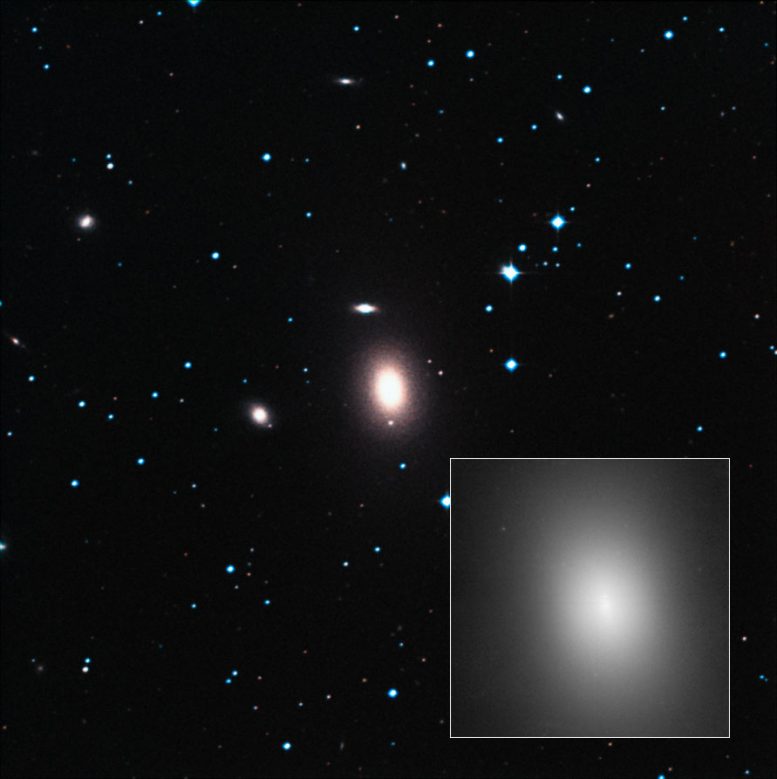
The elliptical galaxy NGC 1600, 200 million light-years away — shown in the center of the image and highlighted in the box —, hosts in its center one of the biggest supermassive black holes known. Until the discovery of this example, astronomers assumed that such huge black holes could only be found in the centers of massive galaxies at the center of galaxy clusters. NGC 1600, however, is a rather isolated galaxy. The image is a composition of a ground-based view and observations made with the NASA/ESA Hubble Space Telescope.
Using the Hubble Space Telescope and the Gemini Telescope in Hawaii, a team of astronomers has uncovered one of the biggest supermassive black holes in an unlikely place: the center of a galaxy that lies in a quiet backwater of the Universe.
Until now, the biggest supermassive black holes — those having more than 10 billion times the mass of our Sun — have only been found at the cores of very large galaxies in the centers of massive galaxy clusters. Now, an international team of astronomers using the NASA/ESA Hubble Space Telescope has discovered a supersized black hole with a mass of 17 billion Suns in the center of the rather isolated galaxy NGC 1600.
NGC 1600 is an elliptical galaxy which is located not in a cluster of galaxies, but in a small group of about twenty. The group is located 200 million light-years away in the constellation Eridanus. While finding a gigantic supermassive black hole in a massive galaxy within a cluster of galaxies is to be expected, finding one in an average-sized galaxy group like the one surrounding NGC 1600 is much more surprising.
“Even though we already had hints that the galaxy might host an extreme object in the center, we were surprised that the black hole in NGC 1600 is ten times more massive than predicted by the mass of the galaxy,” explains lead author of the study Jens Thomas from the Max Planck-Institute for Extraterrestrial Physics, Germany.
Based on previous Hubble surveys of supermassive black holes, astronomers had discovered a correlation between a black hole’s mass and the mass of its host galaxy’s central bulge of stars: the larger the galaxy bulge, the more massive the black hole is expected to be. “It appears from our finding that this relation does not work so well with extremely massive black holes,” says Thomas. “These monster black holes account for a much larger fraction of the host galaxy’s mass than the previous correlations would suggest.”
Finding this extremely massive black hole in NGC 1600 leads astronomers to ask whether these objects are more common than previously thought. “There are quite a few galaxies the size of NGC 1600 that reside in average-size galaxy groups,” explains co-author Chung-Pei Ma, an astronomer from the University of California, Berkeley, USA, and head of the MASSIVE Survey. “We estimate that these smaller groups are about fifty times more abundant than large, dense galaxy clusters. So the question now is: is this the tip of an iceberg? Maybe there are a lot more monster black holes out there.”
It is assumed that this black hole grew by merging with another supermassive black hole from another galaxy. It may then have continued to grow by gobbling up gas funneled to the core of the galaxy by further galaxy collisions. This may also explain why NGC 1600 resides in a sparsely populated region of the Universe and why it is at least three times brighter than its neighbors.
As the supermassive black hole is currently dormant, astronomers were only able to find it and estimate its mass by measuring the velocities of stars close to it, using the Gemini North 8-meter telescope on Mauna Kea, Hawaii. Using these data the team discovered that stars lying about 3000 light-years from the core are moving as if there had been many more stars in the core in the distant past. This indicates that most of the stars in this region have been kicked out from the center of the galaxy.
Archival Hubble images, taken with the Near Infrared Camera and Multi-Object Spectrometer (NICMOS), support the idea that the two merging supermassive black holes in the distant past gave stars the boot. The NICMOS images revealed that the galaxy’s core is unusually faint, indicating a lack of stars close to the galactic center. “We estimate that the mass of stars tossed out of the central region of NGC 1600 is equal to 40 billion Suns,” concludes Thomas. “This is comparable to ejecting the entire disc of our Milky Way galaxy.”
Reference: “A 17-billion-solar-mass black hole in a group galaxy with a diffuse core” by Jens Thomas, Chung-Pei Ma, Nicholas J. McConnell, Jenny E. Greene, John P. Blakeslee and Ryan Janish, 6 April 2016, Nature.
DOI: 10.1038/nature17197









Be the first to comment on "Astronomers Discover a 17 Billion Solar-Mass Black Hole in an Unlikely Place"